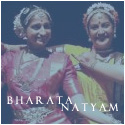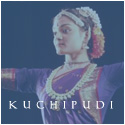|
Dance Styles
Three different classical dance styles of India are currently represented in Kalaa. Eight of the nine dancers are exponents of Bharata Natyam, two dancers are practitioners of Kuchipudi, while one of the dancers is a student of Kathak.
 Perhaps the most easily recognized Classical Dance of India, Bharata Natyam has been nurtured in South India (specifically Tamil Nadu) for thousands of years. Believed to be the oldest of India's Classical dances and the truest to the ancient texts, it began primarily as a devotional dance, performed in temples by Devadasis, women who were bound and dedicated to the temple to serve as dancers and musicians. Perhaps the most easily recognized Classical Dance of India, Bharata Natyam has been nurtured in South India (specifically Tamil Nadu) for thousands of years. Believed to be the oldest of India's Classical dances and the truest to the ancient texts, it began primarily as a devotional dance, performed in temples by Devadasis, women who were bound and dedicated to the temple to serve as dancers and musicians.
Today Bharata Natyam is performed by both men and women. Its long tradition as females' performing art has contributed to its subtle grace. Similarly, the linearity of its movements across the floor can be attributed to the traditional temple setting. Today, there are several different schools of Bharata Natyam in and out of India, further refining and extending this beautiful dance form.

Quite different from Kalaa's other featured dance forms, Kathak comes from North India, where it was influenced by Mughal and Muslim aesthetics. In its early years, it was quite similar to Bharata Natyam but developed into a court entertainment with more emphasis on footwork than on mudras (hand formations). Its intricate footwork and rapid pirouettes make it entertaining to watch.
Today the influence of many cultures can be seen in the costume, subject matter, and music used by Kathak dances. It has been made popular by films and is perhaps as widely recognized as Bharata Natyam.
 Kuchipudi developed in Andhra Pradesh, in the town for which it was named, Kuchelapuri or Kuchelapuram. The whole town was dedicated to the art, which was performed by Brahmin men only. Originally intended for dance-dramas, it was most often performed by groups in elaborate plays on outdoor stages. Kuchipudi separates itself from Bharata Natyam in several ways, a few of which are its unique dances. In some, performers dance while balanced on the edges of a brass plate, carrying a pitcher of water on their heads, and/or locking their toes together. Kuchipudi developed in Andhra Pradesh, in the town for which it was named, Kuchelapuri or Kuchelapuram. The whole town was dedicated to the art, which was performed by Brahmin men only. Originally intended for dance-dramas, it was most often performed by groups in elaborate plays on outdoor stages. Kuchipudi separates itself from Bharata Natyam in several ways, a few of which are its unique dances. In some, performers dance while balanced on the edges of a brass plate, carrying a pitcher of water on their heads, and/or locking their toes together.
Today most Kuchipudi dancers are female, and the dances themselves are very often solos. It has become a graceful and unique stage dance. Still, the art's masculine roots are quite visible in its vigorous movements, and its ground-eating choreography is a legacy of the outdoor stage.
|


![]()